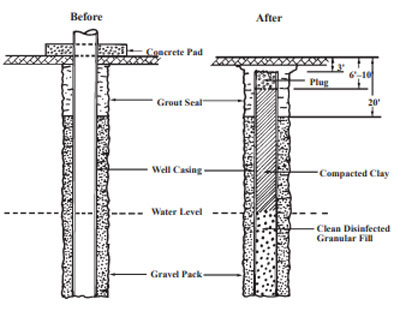Water wells are an extremely important resource for any landowner, but there are some abandoned wells that exist that can pose a hazard to people, animals, and groundwater. An abandoned water well is a well that has been taken out of use, a well that is in such a state of disrepair that using it for any purpose is impractical, or a well that is a physical hazard or threatens to contaminate aquifers.
According to Kansas law K.A.R. 28-30-7, all abandoned water wells are required to be plugged. A landowner is allowed to do this themselves, or they may hire a Kansas-licensed water well contractor to do so. There are both hand-dug wells and cased wells that may need to be abandoned, and they have slightly different methods for plugging.
The general steps for plugging are:
Step 1: Prepare the site by removing all pumping equipment and any debris.
Step 2: Remove the top of the casing and cut off 3 feet below the surface.
Step 3: Disinfect water by adding chlorine, see Table 1 of the K-State Extension publication for the amount needed: MF935 Plugging Abandoned Wells--Water Quality Series
Step 4: Fill the water zone with a porous material, meaning sand or gravel less than 1 inch in size. Refer to the plugging diagrams for examples (Figures 1 & 2).

Figure 1. Plugging diagram for a hand-dug well, before and after plugging.

Figure 2. Plugging diagram for a drilled well, before and after plugging.
Step 5: Add compacted clay above the water zone. Stop when you are five feet below the ground level.
Step 6: Add a grout plug. This can be bentonite clay, cement grout, or neat cement. See the K-State Extension publication for grout recipes, and to estimate how much is needed for your specific well size. MF935 Plugging Abandoned Wells--Water Quality Series. The thickness of the grout plug should be about 6 inches for most wells.
Step 7: Fill in the rest of the hole to the surface using compacted subsoil, and then use topsoil for the very surface. This will settle over time, so mounding the soil up about 10” should be about right.
Step 8: Fill out a plugging record form WWC-5P and submit it to the Kansas Department of Health and Environment’s Bureau of Water-Geology Section. This form is available at: https://www.kdhe.ks.gov/DocumentCenter/View/2216/WWC-5P-Water-Well-Plugging-Record-PDF
For more information:
MF935 Plugging Abandoned Wells--Water Quality Series
Bureau of Water, Geology Section, Water Well Program
Cost-share assistance
Cost-share assistance is available to landowners to plug abandoned wells in most Kansas counties through their local county conservation district. Landowners should contact their local conservation district for county-specific details on landowner cost share limits. According to the Kansas Department of Agriculture-Division of Conservation general policy guidelines for well decommissioning (code 351), a landowner is eligible to receive maximum cost-share assistance of $1,000 per well and may plug multiple wells.
A few important details when receiving cost-share assistance:
- The personnel eligible to plug abandoned wells are either licensed well drillers or the well owner. An exception is on irrigation wells where a licensed well driller must plug the well.
- Gas and oil wells are not eligible for cost-share.
- The Kansas Department of Health and Environment (KDHE) form WWC-5P (Plugging Certification) shall be completed for each well. The original WWC-5P form shall be sent to the Kansas Department of Health & Environment (KDHE), one copy shall be kept in the landowner file, and one copy shall be sent to the water well owner.
DeAnn Presley, Soil Management Specialist
deann@ksu.edu
Peter Tomlinson, Environmental Quality Specialist
ptomlin@ksu.edu
Tags: water quality water wells